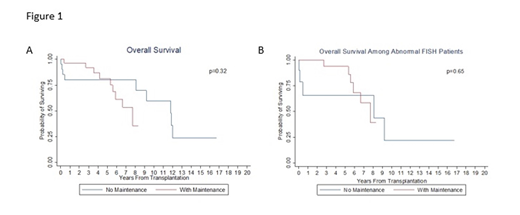Introduction: Autologous stem cell transplantation (ASCT) remains an effective treatment option for many patients with systemic AL amyloidosis (AL). However, the decision to utilize maintenance therapy following ASCT remains controversial and largely unexplored. Studies have shown the benefit of post-ASCT maintenance therapy in multiple myeloma (MM) with lenalidomide, but to date, no study has evaluated maintenance in AL patients following ASCT. Furthermore, the growing relevance of cytogenetics in AL may help dictate the incorporation of maintenance therapy as well. It is also relevant to note the emergence of novel targeted therapy options for AL patients, including the plasma cell monoclonal antibody daratumumab, that could be a valuable addition to combination therapies. As such, the present study aims to a) determine the prognostic significance of utilizing maintenance therapy following ASCT b) assess the potential role of cytogenetics on the efficacy of maintenance treatment, and c) investigate the outcomes of daratumumab-treated patients who have undergone ASCT.
Methods: A retrospective chart review was performed on 50 consecutive AL patients treated at The Ohio State University who underwent ASCT. Patients received high dose Melphalan (140 or 200 mg/m2) prior to ASCT. Patients were divided into subgroups based on FISH data obtained within 90 days of diagnosis, as well as whether or not they had received maintenance therapy following transplant, which was defined as therapy greater than six months following ASCT. Patients' characteristics were summarized using medians and ranges, or frequencies and percentages, and compared using Mann-Whitney rank sum test or fisher exact test. Primary endpoints were progression free survival (PFS) and overall survival (OS), per updated NCCN guidelines, including both organ and hematologic criteria. PFS was defined as the time from date of transplant to day of progression or death from any cause. OS was defined as the time from date of transplant to death from any cause, with censoring those who were still alive at the last follow up. Kaplan-Meier survival function was used to estimate the PFS and OS. The log-rank test was used to test the equality of survivor functions between different groups of patients.
Results: Twenty-eight patients (56%) received maintenance and 22 (44%) did not. Majority of patients received lenalidomide maintenance. The median age at transplant was 58 (range 33-71) years, with 66% male. There was no difference in age, dose of melphalan used, disease stage and number of organs involved between the two groups. There was no statistically significant difference in OS (p=0.32) and PFS (p=0.66) between patients who received maintenance versus those patients who did not receive maintenance (Figure 1A). Among patients with abnormal FISH, there was no difference in survival between these two groups as well (OS: p=0.65; PFS: p=0.15) (Figure 1B). Finally, we tested the efficacy of daratumumab in combination therapy with ASCT in a small patient subset. There was no difference in OS or PFS among patients who underwent ASCT for consolidation, whether or not they received daratumumab.
Conclusion: In this small retrospective analysis, maintenance therapy post ASCT had no impact on the PFS or OS of patients with AL. Furthermore, survival was not affected by maintenance in patients with cytogenetic abnormalities or addition of novel monoclonal antibodies. A larger prospective study is needed to assess the benefit of maintenance post ASCT and daratumumab in AL amyloid patients.
Rosko:Vyxeos: Other: Travel support. Efebera:Janssen: Speakers Bureau; Akcea: Other: Advisory board, Speakers Bureau; Takeda: Honoraria.
Author notes
Asterisk with author names denotes non-ASH members.


This feature is available to Subscribers Only
Sign In or Create an Account Close Modal